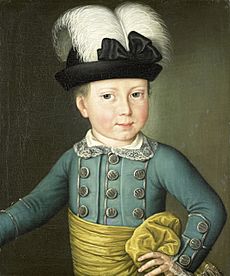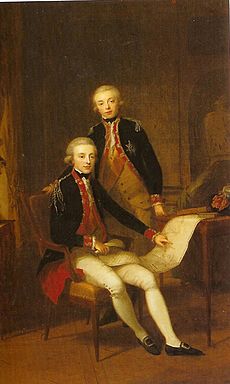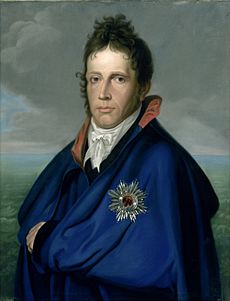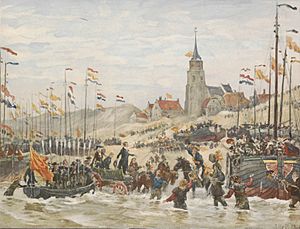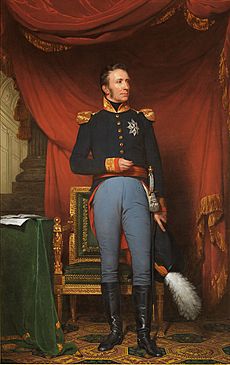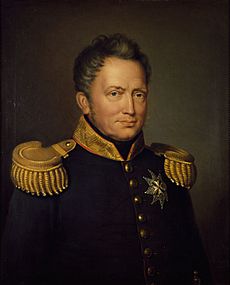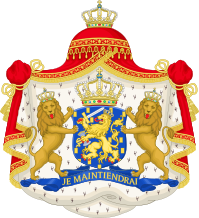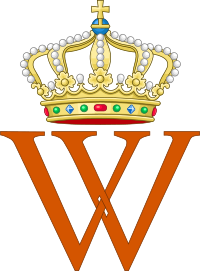William I of the Netherlands facts for kids
Quick facts for kids William I |
|
|---|---|
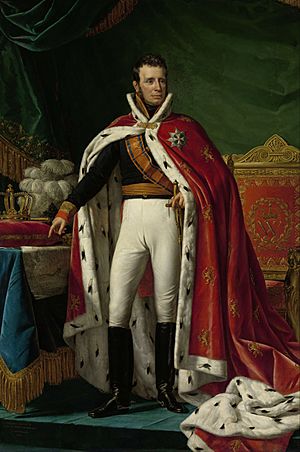
William in ceremonial robes, by Joseph Paelinck, 1819
|
|
| King of the Netherlands Grand Duke of Luxembourg |
|
| Reign | 16 March 1815 – 7 October 1840 |
| Inauguration | 21 September 1815 |
| Predecessor | Louis II as King of Holland |
| Successor | William II |
| Sovereign Prince of the Netherlands | |
| Reign | 20 November 1813 – 16 March 1815 |
| Successor | Himself as King |
| Prince of Orange-Nassau | |
| Reign | 9 April – 12 July 1806, 19 October 1813 – 31 May 1815 |
| Predecessor | William V, Prince of Orange |
| Successor | Incorporated into Nassau |
| Prince of Nassau-Orange-Fulda | |
| Reign | 25 February 1803 – 27 October 1806 |
| Duke of Limburg | |
| Reign | 5 September 1839 – 7 October 1840 |
| Predecessor | Francis I |
| Successor | William II |
| Born | 24 August 1772 Huis ten Bosch, The Hague, Dutch Republic |
| Died | 12 December 1843 (aged 71) Berlin, Kingdom of Prussia |
| Burial | Nieuwe Kerk, Delft |
| Spouse | |
| Issue | William II of the Netherlands Prince Frederick Princess Pauline Princess Marianne |
| House | Orange-Nassau |
| Father | William V, Prince of Orange |
| Mother | Princess Wilhelmina of Prussia |
| Religion | Dutch Reformed Church |
William I (born Willem Frederik, Prince of Orange-Nassau; August 24, 1772 – December 12, 1843) was a very important leader in Dutch history. He was the first King of the Netherlands and also the Grand Duke of Luxembourg.
William was the son of the last Stadtholder of the Dutch Republic, William V. His family had to leave the Netherlands in 1795 because of the Batavian Revolution. Later, William became the ruler of a new area called the Principality of Nassau-Orange-Fulda in 1803. But Napoleon took this away in 1806.
After his father died, William became the Prince of Orange. When Napoleon was defeated in 1813, William got his lands back. He was asked to become the Sovereign Prince of the United Netherlands. He then declared himself King of the Netherlands on March 16, 1815. He also became the Grand Duke of Luxembourg and later the Duke of Limburg. He gave up his throne in 1840.
Contents
Becoming Prince of Orange
William I's parents were William V, Prince of Orange, the last stadtholder of the Dutch Republic, and Wilhelmina of Prussia. From his birth until 1806, people called him Erfprins (Hereditary Prince). This helped tell him apart from his father.
On October 1, 1791, William married his cousin, Wilhelmina of Prussia. She was the daughter of King Frederick William II of Prussia. After Wilhelmina passed away in 1837, William married Countess Henriette d'Oultremont de Wégimont in 1841.
His Early Life and Military Training
William and his younger brother, Prince Frederick of Orange-Nassau, had special teachers. They learned math from Leonhard Euler and history from Herman Tollius. They also learned military skills from General Prince Frederick Stamford.
In 1788–89, William went to a military academy in Brunswick. In 1790, he became a general in the Dutch army. He also joined the Council of State of the Netherlands. In November 1791, he brought his new wife to The Hague.
When France declared war on the Dutch Republic in 1793, William became the commander of the Dutch army. He fought in several battles, including the Flanders Campaign. He even replaced a general named Kaunitz as commander of the combined Austrian-Dutch forces.
However, the French armies were too strong. The Dutch and their allies were defeated at the Battle of Fleurus (1794). In January 1795, the French entered the Netherlands. William's father decided to flee to Britain, and William went with him. The next day, the Batavian Republic was created.
Life in Exile
After leaving Britain, William tried to gather an army to invade the Batavian Republic. But the Prussian government stopped him.
In 1799, William took part in an Anglo-Russian invasion of Holland. He helped cause a mutiny (rebellion) on some Dutch naval ships, which then surrendered to the British. However, the Dutch people did not rise up to support him as he had hoped. After some battles, William had to leave the country again.
Many Dutch soldiers who had joined William formed the King's Dutch Brigade and served the British. When peace was made between Britain and France in 1802, the Dutch Brigade was disbanded.
William visited Napoleon Bonaparte in 1802. Napoleon gave William hope that he could play a role in the Netherlands. William's brother-in-law, Frederick William III of Prussia, helped the House of Orange get some lands in Germany. These lands became the Principality of Nassau-Orange-Fulda. William's father gave this new principality to him.
In 1806, war broke out between France and Prussia. William supported his Prussian relatives, even though he was technically a French vassal. He commanded a Prussian division in the Battle of Jena–Auerstedt. The Prussians lost, and William had to surrender his troops. Napoleon punished him by taking away his principality.
In the same year, William's father died. William inherited his father's title and claims to the Nassau lands. This would be important later. In 1809, William joined the Austrian army and fought in the Battle of Wagram, where he was wounded.
Tsar Alexander I of Russia played a big part in helping the Netherlands become independent again. William met with Alexander in 1813, and Alexander promised to help him. British leaders also agreed to support William.
Returning to the Netherlands
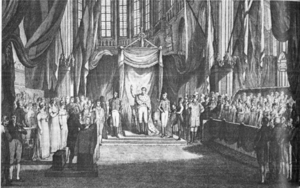
After Napoleon's defeat at Leipzig in October 1813, French troops left Europe. The Netherlands had been part of the French Empire. But now, French soldiers were leaving Dutch cities.
A group of Dutch politicians formed a temporary government in November 1813. They decided that William should lead the new government. They wanted the Dutch people to restore him themselves, rather than having other powerful countries force him on them. The Dutch people were happy the French were gone and welcomed William.
On November 30, 1813, William landed at Scheveningen beach. This was almost the same spot where he had left with his father 18 years before. On December 6, the government offered him the title of King. William refused, choosing instead to be called "Sovereign Prince of the Netherlands". He also wanted a "wise constitution" to protect the rights of the people.
The new constitution gave William a lot of power. Ministers were only answerable to him. The parliament, called the States General, had limited power. William became sovereign prince in the New Church in Amsterdam on March 30, 1814.
In August 1814, William became Governor-General of the former Austrian Netherlands (which is now Belgium) and the Prince-Bishopric of Liège. He also became the Grand Duke of Luxembourg. This was part of a deal where he gave up his German lands. Powerful countries had agreed to unite the Low Countries into one kingdom. They believed a strong country on the North Sea would help control France. With these new lands, William achieved his family's long-held dream of uniting the Low Countries.
William Becomes King of the Netherlands
Napoleon escaped from Elba in 1815. Feeling threatened, William declared the Netherlands a kingdom on March 16, 1815. This was encouraged by the countries at the Congress of Vienna. His son, who would become King William II, fought as a commander at the Battle of Waterloo.
After Napoleon was defeated again, William created a new constitution. It still gave him a lot of power. The Congress of Vienna officially confirmed him as the hereditary ruler of what was called the United Kingdom of the Netherlands.
Key Changes and Policies
The States General was split into two parts. The Eerste Kamer (First Chamber) was chosen by the King. The Tweede Kamer (Second Chamber) was elected by regional governments. These regional governments were chosen by people who owned enough property. The 110 seats in parliament were split equally between the North and the South. This was unfair because the South had more people (3.5 million) than the North (2 million). The main job of the States General was to approve the King's laws.
The North accepted the constitution, but the South did not. The unfair representation of the South was one reason for the Belgian Revolution later on. William said that people who didn't vote "no" were voting "yes." He had a grand inauguration in Brussels and gave out copper coins, which earned him the nickname the Copper King.
King William's main goal was to make the country's economy strong. He started many trade organizations, earning him another nickname: the King-Merchant. In 1822, he founded a company that became very important in Belgium after it became independent. Industry grew, especially in the South. In 1817, he also started three universities in the Southern provinces: a new University of Leuven, the University of Ghent, and the University of Liège.
The Northern provinces were the center of trade. This, along with the colonies (like the Dutch East Indies and Surinam), made the Kingdom very rich. However, most of this money went to Dutch leaders. Only a few Belgians benefited from this growth. This feeling of unfairness was another reason for the Belgian uprising.
William also wanted to unite the people. But the North and South had become very different. The North was mostly Protestant, Dutch-speaking, and focused on trade. The South was mostly Roman Catholic, industrial, and had both Dutch and French speakers.
Even though the country officially separated church and state, William strongly supported the Dutch Reformed Church. This made people in the mostly Catholic South unhappy. William also made unpopular rules about language and schools. Dutch became the official language in Flanders, which angered French-speaking people. Schools had to teach the Reformed faith and the Dutch language. Many in the South worried that the King wanted to get rid of Catholicism and the French language.
The Southern Provinces Revolt
In August 1830, an opera called La muette de Portici was performed in Brussels. This opera, about people fighting against unfair rule, seemed to spark a strong feeling of nationalism and dislike for the Dutch in Brussels. Riots started, mainly against the unpopular justice minister, Cornelis Felix van Maanen.
An angry William sent troops to stop the riots. But the riots spread to other Southern cities and quickly became a popular uprising. This led to the independent country of Belgium.
The next year, William sent his sons, William and Frederick, to invade the new state. They were successful at first in the Ten Days' Campaign. But the Dutch army had to retreat when France threatened to intervene. Some people in Belgium still supported William, but the Dutch never got control of Belgium back.
William continued the war for eight more years. His economic successes were overshadowed by how he handled the war. The high costs of the war hurt the Dutch economy and made people angry. In 1839, William was forced to end the war. The United Kingdom of the Netherlands was broken up by the Treaty of London (1839). The northern part continued as the Kingdom of the Netherlands.
Later Life and Giving Up the Throne
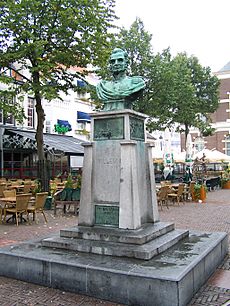
In 1840, changes were made to the constitution. These changes included making ministers responsible to parliament, not just the King. William was very conservative and did not like these changes. Also, he was disappointed about losing Belgium. He also wanted to marry Henrietta d'Oultremont, who was from Belgium and Catholic.
Because of these reasons, William decided to give up his throne. He did this on October 7, 1840. His oldest son became King William II. William I died in 1843 in Berlin when he was 71 years old.
William's Children
With his wife Wilhelmina, King William I had six children:
- Willem Frederik George Lodewijk (born December 6, 1792 – died March 17, 1849). He later became King William II of the Netherlands. He married Grand Duchess Anna Pavlovna of Russia.
- A son who was stillborn (born August 18, 1795).
- Willem Frederik Karel (born February 28, 1797 – died September 8, 1881). He married his cousin Louise.
- Wilhelmina Frederika Louise Pauline Charlotte (born March 1, 1800 – died December 22, 1806).
- A son who was stillborn (born August 30, 1806).
- Wilhelmina Frederika Louise Charlotte Marianne (born May 9, 1810 – died May 29, 1883). She married Prince Albert of Prussia. They divorced in 1849.
Honors and Symbols
Honors
 Netherlands:
Netherlands:
- Founder and Grand Master of the Military Order of William, April 30, 1815
- Founder and Grand Master of the Order of the Netherlands Lion, September 29, 1815
 Sweden: Knight of the Order of the Seraphim, April 14, 1813
Sweden: Knight of the Order of the Seraphim, April 14, 1813 Spain: 876th Knight of the Order of the Golden Fleece, July 5, 1814
Spain: 876th Knight of the Order of the Golden Fleece, July 5, 1814 United Kingdom:
United Kingdom:
- 648th Knight of the Order of the Garter, August 10, 1814
- Honorary Knight of the Order of the Bath, August 16, 1814; Grand Cross (military), January 2, 1815
 Prussia: Knight of the Order of the Black Eagle, February 8, 1787
Prussia: Knight of the Order of the Black Eagle, February 8, 1787 Portugal: Grand Cross of the Sash of the Three Orders, October 1825
Portugal: Grand Cross of the Sash of the Three Orders, October 1825 Austria: Grand Cross of the Order of St. Stephen, 1837
Austria: Grand Cross of the Order of St. Stephen, 1837 Saxe-Weimar-Eisenach: Grand Cross of the Order of the White Falcon, November 20, 1839
Saxe-Weimar-Eisenach: Grand Cross of the Order of the White Falcon, November 20, 1839
Coat of Arms
| Royal coat of arms of King William I | Royal monogram |
See also
 In Spanish: Guillermo I de los Países Bajos para niños
In Spanish: Guillermo I de los Países Bajos para niños


